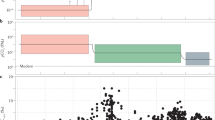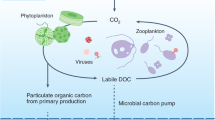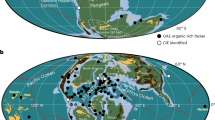Abstract
The rise of oxygenic photosynthesis nearly three billion years ago led to the accumulation of free oxygen and to the subsequent diversification of life on Earth; today, nearly half of all oxygen production derives from the photosynthetic activities of marine phytoplankton1. The conclusion that the open sea –– and therefore much of our planet's surface –– is in a net heterotrophic metabolic state2,3,4 is enigmatic and is a first-order question in the global carbon cycle, as discussed by del Giorgio and Duarte5. Our findings suggest that autotrophy in the open sea is episodic and decoupled from the more constant heterotrophic processes. Consequently, the metabolic balance of the open sea depends on proper space and timescale integration to achieve an ecological understanding of life in the sea.
This is a preview of subscription content, access via your institution
Access options
Subscribe to this journal
Receive 51 print issues and online access
$199.00 per year
only $3.90 per issue
Buy this article
- Purchase on SpringerLink
- Instant access to full article PDF
Prices may be subject to local taxes which are calculated during checkout

Similar content being viewed by others
References
Field, C. B., Behrenfeld, M. J., Randerson, J. T. & Falkowski, P. Science 281, 237–240 (1998).
del Giorgio, P. A., Cole, J. J. & Cimbleris, A. Nature 385, 148–151 (1997).
Duarte, C. M. & Agustí, S. Science 281, 234–236 (1998).
Duarte, C. M., Agustí, S., del Giorgio, P. A. & Cole, J. J. Science 284, 1735 (1999).
del Giorgio, P. A. & Duarte, C. M. Nature 420, 379–384 (2002).
Emerson, S. et al. Nature 389, 951–954 (1997).
Emerson, S., Quay, P. D., Stump, C., Wilbur, D. & Schudlich, R. J. Geophys. Res. 100, 15873–15887 (1995).
Najjar, R. G. & Keeling, R. F. Global Biogeochem. Cycles 14, 573–584 (2000).
Karl, D. M., Bidigare, R. R. & Letelier, R. M. in Phytoplankton Productivity and Carbon Assimilation in Marine and Freshwater Ecosystems (eds Williams, P. J. leB., Thomas, D. R. & Reynolds, C. S.) 222–264 (Blackwell, London, 2002).
McGillicuddy, D. J. Jr et al. Nature 394, 263–266 (1998).
Uz, B. M., Yoder, J. A. & Osychny, V. Nature 409, 597–600 (2001).
Gregg, M. C., Sanford, T. B. & Winkel, D. P. Nature 422, 513–515 (2003).
Young, R. W. et al. Global Biogeochem. Cycles 5, 119–134 (1991).
Author information
Authors and Affiliations
Corresponding author
Rights and permissions
About this article
Cite this article
Karl, D., Laws, E., Morris, P. et al. Metabolic balance of the open sea. Nature 426, 32 (2003). https://doi.org/10.1038/426032a
Issue date:
DOI: https://doi.org/10.1038/426032a
This article is cited by
-
Change in rheotactic behavior patterns of dinoflagellates in response to different microfluidic environments
Scientific Reports (2021)
-
Extreme rates and diel variability of planktonic respiration in a shallow sub-arctic lake
Aquatic Sciences (2019)
-
Size fraction of phytoplankton and the contribution of natural plankton to the carbon source of Zhikong scallop Chlamys farreri in mariculture ecosystem of the Sanggou Bay
Acta Oceanologica Sinica (2017)
-
Both respiration and photosynthesis determine the scaling of plankton metabolism in the oligotrophic ocean
Nature Communications (2015)
-
Surface Water Metabolism Potential in Groundwater-Fed Coastal Waters of Hawaii Island, USA
Estuaries and Coasts (2014)



